Tuesday, March 12 and Friday, March 22, will consist of an introduction, necessary training and plenary lectures in the morning, and then Facility Tour to Tsukuba and Tokai campuses in the afternoon.
There is a
special security guard in our indico system in KEK. You'll be asked
username and password in a pop-up window when you access our indico
site. Please enter username "kds" and the password which is written in
the pop-up window. Then, you should be able to access the page. The
password will be changed daily.
Laboratory program will be held in Tsukuba and Tokai Campus.
NEU and TSB programs are in Tokai and the other is in Tsukuba.
| DAQ: FPGA and DAQ system |
Convener; Yoichi Igarashi (KEK)
Masaharu Nomachi(Osaka Univ.)
Shohei Nishida(KEK)
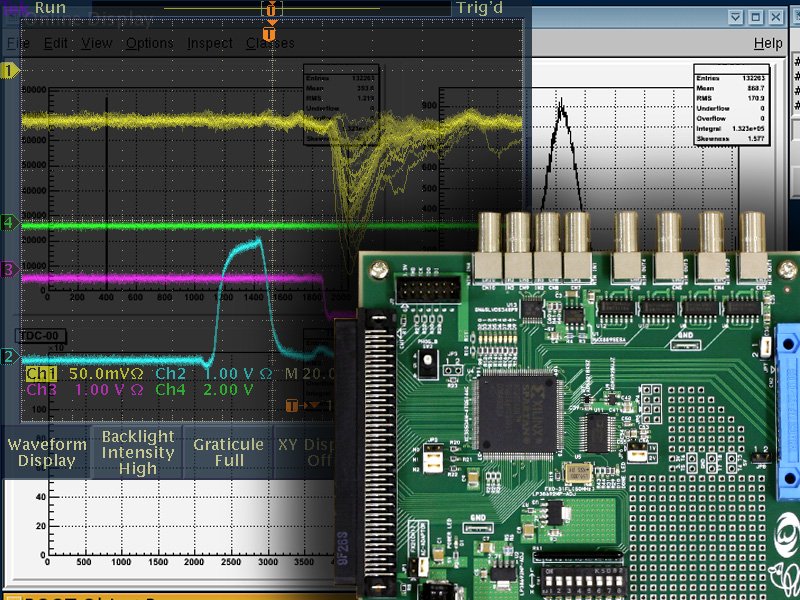 |
The students will have experiences with the mechanism of the digital measurements using FPGA (Field Programmable Gate Array) and the data acquisition (DAQ).
In this training, the students will learn about follows.
* Basic of the FPGA, how and why it works in the particle measurements.
* Basic of the DAQ, usage of the computer in the measurements and the
structure of the measurement software
The students will learn the beginning of HDL (Hardware Description
Language) and make measurement devices such as Scaler and TDC (Time to
digital converter) using a FPGA test board. They will also learn the
behavior of DAQ to make the simplest DAQ software. A small measurement
system will appear just before them by their works during the training
course. They will measure the cosmic ray using their own measurement
devices and their own system at the goal.
Requirements of the applicants:
* Basic literacy of the computer: Almost practrical training will be
performed using the common PC.
* Elementary knowledge of the digital circuit
* Elementary knowledge of the C and C++ language |
| STD: Silicon Tracking Detector |
Convener; Yoichi Ikegami (KEK)
Kazuhiko Hara (Univ. Tsukuba)
Tsutomu Mibe(KEK)
Ryuma Hori (KEK)
Shingo Mitsui (KEK)
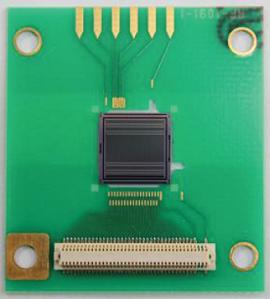 |
Students will start to learn the principle of operation of silicon
sensors, finally they try to reconstruct cosmic ray tracks.
Schedule :
1st day
Students take a lecture for silicon semiconductor detector. They make a
miniature detector sample.
2nd day
They measure basic characterization (IV curve and CV curve) for the
detector sample.
3th day
They learn how to readout signal from silicon sensors and try to take
cosmic rays data by setting a tracking detector system. The system
will be operated over a night.
4th day
They learn how to perform track reconstruction from the taken comic ray
data. |
| NEU: Neutrino Detector |
Convener; Masashi Yokoyama (The Univ. of Tokyo)
Tsuyoshi Nakaya (Kyoto Univ.)
Akihiro Minamino (Kyoto Univ.)
Toshifumi Tsukamoto (KEK)
Takeshi Nakadaira (KEK)
Taku Ishida (KEK)
Ken Sakashita(KEK)
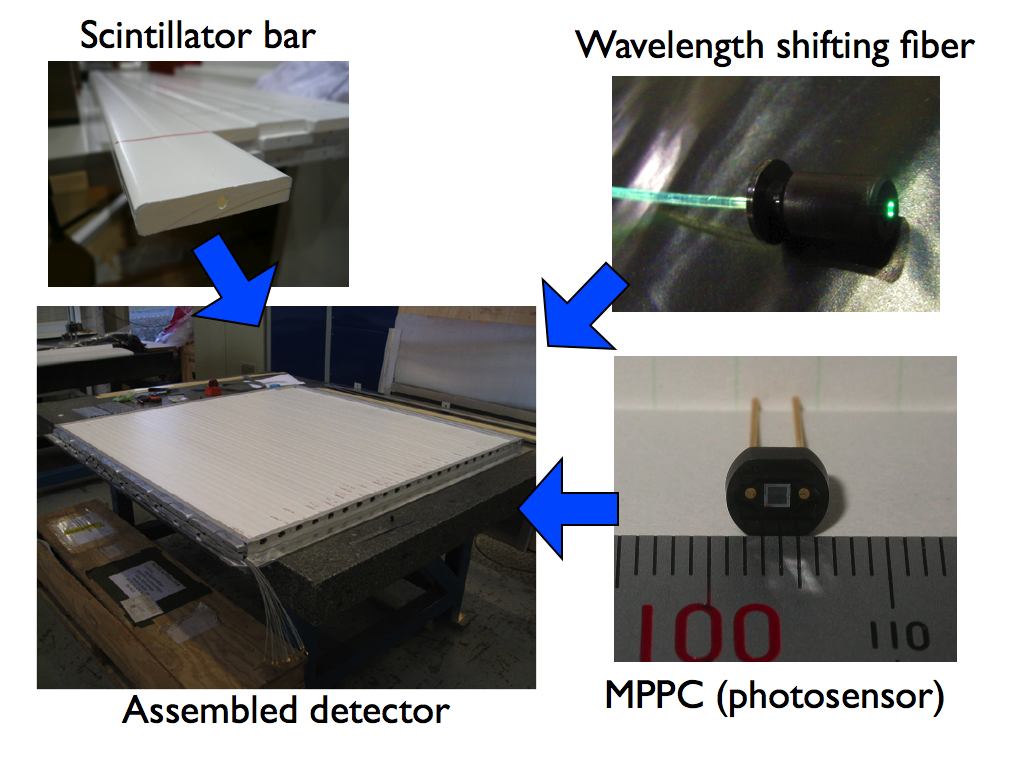
Plastic scintillators, wavelength shifting fibers, MPPCs (photosensors)
and an assembled particle (neutrino) detector. |
Neutrino Detector
Students will learn the basics of detectors consisting of plastic
scintillators, wavelength shifting fibers, and silicon photodetectors
(Multi-pixel Photon Counter, MPPC). This type of detector is used as a
fundamental block of near neutrino detectors for the T2K accelerator
neutrino experiment. They will learn the principle of scintillator,
light collection using wavelength shifting fibers, and operation of MPPC
through measurements of their properties. In the end, they will
construct a small detector using the above technique, detect real
partilces (e.g. from neutrino beam, charged particle beam, or cosmic
ray), and evaluate the performance of constructed detector as an
integrated particle detection system.
|
| SUP: Superconducting Detector |
Convener; Atsuko Kibayashi (Okayama Univ.)
Jihoon Choi (Korea Univ.)
Mitsuhiro Yoshida (KEK)
Masashi Hazumi (KEK)
Nobuaki Sato (KEK)
Hirokazu Ishino (Okayama Univ.)
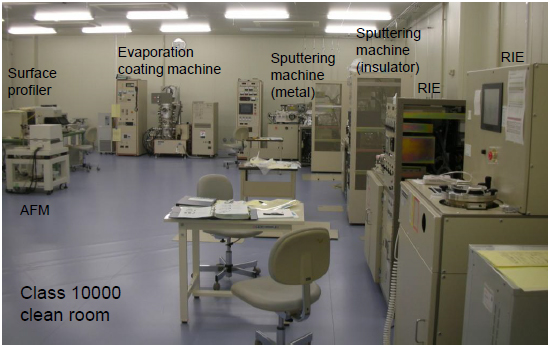
Class 10k cleanroom facility at KEK |
Microwave Kinetic Inductance Detectors (MKIDs) are a kind of superconducting detectors. Since the MKIDs were first devised a decade ago, they have gained much attention for their simple approach to multiplexing and making large arrays. They are especially recognized as next-generation detectors in millimeter and sub-millimeter astronomy including measurements of the Cosmic Microwave Background, and also as phonon detectors in the dark matter search.
MKIDs require simple and basic steps to fabricate, and are thus suitable for beginning students’ exercises.
Our superconducting detector R&D group has been fabricating MKIDs since 2010 in cleanrooms at KEK: a Class 10k cleanroom is equipped with sputtering/etching machines and a Class 1k yellow room for lithographic processes; a Class 100k cleanroom has a dicing saw, a bonding machine, and a Helium-3 sorption refrigerator. Students will gain hands-on experience of a superconducting device fabrication in the clean environment.
An introductory lecture will be given first on the detection principle of MKIDs before students begin the fabrication process.
Students will learn a lift-off technique to form the pattern on a silicon wafer. In the Class 10k cleanroom, each student will go through the following process to fabricate his/her own MKIDs: print a pattern on the silicon wafer using a mask aligner, thereby learning a lithography technique; observe and inspect the pattern under a microscope; deposit a thin metal film on the printed wafer, by operating a sputtering machine; “lift-off” the unwanted pattern by removing the photo-resist layer under the deposited metal film; measure the height of the deposited film with a surface profile meter.
In the Class 100k cleanroom, students will learn how to operate the dicing saw to cut the wafer to make individual chips, and use the wire bonder to integrate the chip with readout electronics. Finally students will place the chip in the Helium-3 sorption refrigerator to cool it down 0.3K, measure the resonance peaks with a vector network analyzer and power of the injected millimeter wave, and evaluate their own MKIDs’ performance. |
| PHD: Photon Detector |
Convener; Koji Yoshimura (KEK)
Ichiro Adachi (KEK)
Isamu Nakamura (KEK)
Peter Krizan (Ljubljana Univ.)
Samo Korpar (Ljubljana Univ.)
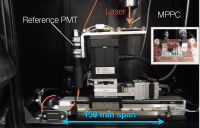

|
The objective of this course is to learn the basics of two typical photon sensors, photo-multiplier tube (PMT) and Geiger-mode APD (SiPM/MPPC), both of which are now commonly used in various experiments. Starting with learning how to operate sensors, calibration and evaluation of the various characteristics are performed through comparison of the sensors. These basics would be essential to design and operate the particle detectors with various types of photon sensors.
The practical course is organized as following subjects and learnings.
- Principle and operation of the photon sensors
Making the hardware for testing the devices, i.e. circuit boards to apply bias voltage to SiPM/MPPC and to drive LED, and simple dark box for light-shield.
Observation of sensor signal using oscilloscope
- Calibration using LED light source
Readout electronics (NIM, CAMAC), simple data acquisition system, and data analysis (some statistics)
- Environmental (temperature) test using thermal chamber
Temperature dependences of each characteristics.
- Evaluation using focused light with a laser microscope
Photon detection efficiency with different wavelength light.
Effect of geometrical pixel layout. |
| LIQ: Liquid Noble Gas Detector |
Convener; Toshiaki Tauchi (KEK)
Takasumi Maruyama (KEK)
Satoshi Mihara (KEK)
Katsuyu Kasami (KEK)
Akihiro Maki (KEK)
Takayuki Saeki (KEK)
Shuji Tanaka (KEK)
Tomiyoshi Haruyama (KEK)
Shogo Nakamura (Yokohama National Univ.)
Toshinori Mori(Univ. of Tokyo)
Akira Sugiyama (Saga Univ.)
Masayuki Kumada (NIRS)
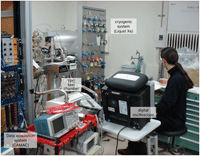
Experimental setup for test of prototype TPC with liquid xenon. The cryogenic system consists of a control panel, cryogenic cooler of pulse tube type, compressor, vacuum pumps, a purification getter and a storage tank of xenon gas. The data acquisition system consists of NIM and CAMAC modules. Also, the data can be analyzed by using digital oscilloscopes. |
Students will learn basic properties of liquid noble gas detector by observing scintillation lights and ionization charges. They also learn how gamma rays interact with the noble gas characterizing photoelectric effect, Compton scattering by using various radiation sources. Since alpha particles and neutrons interact differently from gammas and electrons with the noble gas, the particle species can be discriminated by time envelop of scintillation lights. The ionization charges will be detected in a Time Projection Chamber (TPC), where three dimensional position of interaction is measured as well as amount of charges. Students will learn the principle of TPC. Especially, students will discuss a mechanism of charge transfer through a measurement of charge drift velocity in TPC. Correlation between scintillation lights and ionization charges is an interesting subject for dark matter searches. Noble gases are liquefied at low temperature, i.e. 87K and 165K for argon and xenon, respectively, at 1 atmosphere. Students will learn a principle of cryogenic system with purification at impurity of ppb (parts per billion) level. There will be lectures on experiments (ICARUS, MEG, XMASS, XENON etc.) and medical application (PET) with the use of liquid noble gas detector. |
| GAS: Gas Tracking Detector |
Convener; Shoji Uno (KEK)
Kyoichiro Ozawa(KEK)
Kentaro Miuchi(Kobe Univ.)

Photograph of Cylindrical Drift Chamber, which is commonly used at particle
physics experiments |
Objects of the course is to know basics of gas tracking detectors thorough
several hands-on experiences. Students will learn about several features of
the interactions between particles and materials.
We have following training items in the course.
- Make a small wire chamber
- Learn characteristics of the wire chamber using Fe-55 radiation source
- Learn characteristics of the wire chamber using Sr-90 radiation source
- Learn characteristics of a drift chamber using two wire chambers
- Measurements of cosmic-ray distribution
In addition, we are planning to have two dimensional measurements using a
GEM detector or uPic.
|
| TSB: Practice with Test Beam |
Convener; Kyoichiro Ozawa (KEK)
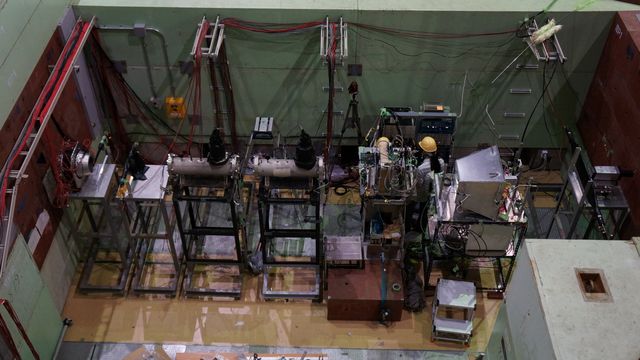 Photograph of K1.1 BR experimental area at J-PARC hadron hall with some
detectors. Photograph of K1.1 BR experimental area at J-PARC hadron hall with some
detectors. |
This course aims to provide experiences about a detector test using a beam.
The course will be carried out at Hadron-hall in J-PARC, Tokai. Students
will learn about basic handlings of tracking and particle identification
detectors.
The setup is similar with a detector test experiment. The beamline of K1.1BR
will be used. Following detectors will be set up in line. Time of Flight
counter (for Proton/Kaon/Pion identification) Gas Chrenkov counter (For
electron identification) Aerogel Chrenkov counter (for Kaon/Pion
identification) Multiwire propotional Chamber Lead Glass Calorimeter (For
electron energy detection)
Students will take data using above detectors and have chance to analyze
acquired data.
The beam time of J-PARC is not fixed yet. In case, we are preparing a cosmic
ray stand at Tsukuba for this course instead of the beam. |









 Photograph of K1.1 BR experimental area at J-PARC hadron hall with some
detectors.
Photograph of K1.1 BR experimental area at J-PARC hadron hall with some
detectors.